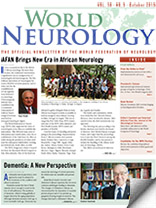By John D. England, MD, Editor-in-Chief

John D. England
The editorial staff of the Journal of the Neurological Sciences (JNS) and Elsevier have been working closely with the organizers of the upcoming XXII World Congress of Neurology (WCN) to provide easy access to the 1,461 abstracts being presented there. All of the abstracts will be published in JNS and will be available online as open access just before the congress begins.
Additionally, there will be a congress app, which will include a link to the journal to ensure that attendees can view all the abstracts. The congress venue will have WiFi in the public areas. Attendees without smartphones or mobile devices will be able to access the abstracts at Internet and abstract viewing stations. I believe that these processes will enhance everyone’s educational and social experiences at the congress. I look forward to meeting with many of you at the WCN 2015 in Santiago, Chile.
In our ongoing attempt to enhance accessibility of JNS articles to members of the World Federation of Neurology, we have selected two more free-access articles, which are profiled in this issue of World Neurology.
- Wildea Lice de Carvalho Jennings Pereira, et al., provides a comprehensive review of neuromyelitis optica (NMO). Ever since the discovery of the specific antibody against aquaporin-4 (anti-AQP4), which is associated with NMO, there has been great interest in this disease. Most of the major neurology and neuroscience journals, including JNS, publish several original articles each year describing new aspects of NMO. This article is very useful and timely, since it summarizes the current knowledge of the epidemiological, clinical and immunological aspects of the disease. It also describes the currently recommended treatment strategies for NMO. W.L. de Carvalho J. Pereira, E.M.V. Reiche, A.P. Kallaur, D.R. Kaimen-Maciel, “Epidemiological, Clinical and Immunological Characteristics of Neuromyelitis Optica: A Review,” J. Neurol. Sci. 355 (2015): 7-17.
- Joerg-Patrick Stubgen provides a summary of the types of peripheral neuropathies that are associated with lymphoma. Clinically-evident “dysimmune” neuropathies occur in approximately 5 percent of patients with lymphoma; however, electrophysiologically-evident neuropathies have been reported in as many as 35 percent of patients with various types of lymphoma. And, these prevalence assessments do not include the frequent treatment associated (largely chemotherapy-induced) peripheral neuropathies. The spectrum of peripheral neuropathies associated with lymphomas is wide, and the etiology is complex and poorly understood. As emphasized in the article, accurate clinical diagnosis of the type of neuropathy and proper categorization of lymphoma are both important to ensure selection of the most appropriate and effective treatment strategies. J-P.Stubgen, “Lymphoma-associated Dysimmune Polyneuropathies,” J. Neurol. Sci. 355 (2015): 25-36.
